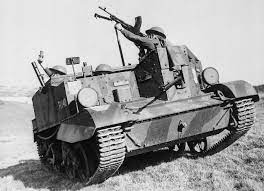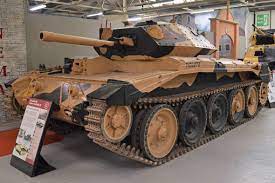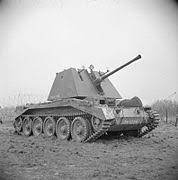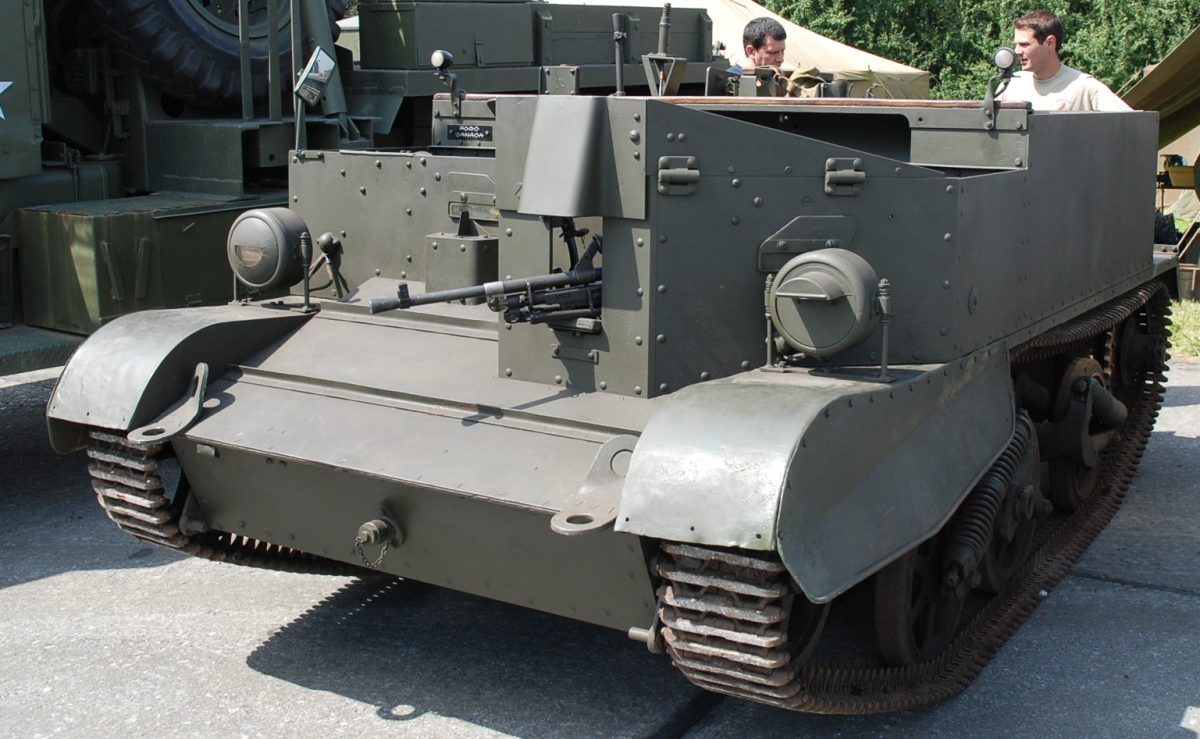Before we discuss the next vehicle, there is some background information necessary, because the next vehicle is not a tank but an armored personnel carrier, or APC for short. APCs were first used in World War II and the Cold War. It was used in many roles, such as to move troops, carry infantry into battle, move ammunition and weaponry, scout, and act as a mobile command center. However, their major use remains to bring troops into battle and give the infantry that it carries protection and extra firepower. This was done by giving it the titular armor, as well as a defensive weapon such as a machine gun or a light cannon.
The first real APC was the Universal, more commonly known as the Bren carrier. The carrier went through many variations and was armed with many things so, for the specifications part, I will be focusing on the troop carrier versions.
 It almost always had a main hull mounted armament of either a 14.7mm Boys anti tank rifle or a 7.62 Bren machine gun. The carrier was armed with a secondary weapon of either a Vickers 12.7mm medium/heavy machine gun or a 7.62mm Bren gun. It had between 7 and 10 millimeters of armor, which was not much, but could stop pistols and some small arms fire, while at least softening the blow of higher-caliber weapons, such as larger rifles and lower-caliber light machine guns.
It almost always had a main hull mounted armament of either a 14.7mm Boys anti tank rifle or a 7.62 Bren machine gun. The carrier was armed with a secondary weapon of either a Vickers 12.7mm medium/heavy machine gun or a 7.62mm Bren gun. It had between 7 and 10 millimeters of armor, which was not much, but could stop pistols and some small arms fire, while at least softening the blow of higher-caliber weapons, such as larger rifles and lower-caliber light machine guns.
Past the Mk. 2 variant, the design also incorporated a four-inch smoke mortar to protect the vehicle by preventing enemies from easily seeing the vehicle or the surrounding forces. It could go at around 48 km/h, which allowed it a to enter the battle quickly, before heavy fire could be used to destroy or severely damage the vehicle. It had a crew of three and could usually carry around 6 to 10 infantrymen, but typically also carried some extra infantrymen sitting on top.
The vehicle was also used in an anti-tank role. It was equipped with a two-pounder 40mm or four-pounder 57mm gun, both of which would be mounted above where the infantry would have been, replacing the infantry compartment with a place for the new crew and a place to store the ammunition. There were also variants used in an indirect fire support role. A number of the carriers were modified to carry either a two-inch or a three-inch mortar, with a notable number of these being made by the Australians.
There was also a variant called the Wasp, which replaced its armament on the front with a flamethrower and fuel tanks for the weapon, and was used in a reconnaissance role. Some of these were used as forward artillery observation vehicles, given a radio to report coordinates for barrages. Others were used as scout cars, with many variants and often also equipped with radios. It was also sometimes used in a tractor role.
On every variation past the Mk.2, the carrier included a towing hitch, which could be used to transport small artillery pieces, anti-tank guns, and other assorted pieces of equipment. This version saw action on almost every front, including the Pacific, China, the Eastern Front, Operation Overlord, Italy, North Africa, and even in the invasion and subsequent occupation of Iceland. The Allies also supplied Chinese forces with up to 1,000 carriers, a significant number of which were mortar versions.
One of the most weird and inventive uses of the vehicle was actually by the Germans. The Axis forces used many captured vehicles during the war, and the Bren carrier was no exception, but how it was used here was odd, to say the least. The Germans decided to do a bit of “innovation”: equipping it with an ungodly amount of explosives and a remote control system, including a remote-control driving system and a remote detonation system. They were used most in the siege of Sevastopol, where the Axis forces drove 99 of them at the Soviet defenses and blew them up. Most fell victim to artillery barrages and landmines before reaching their targets, but some worked. The fact that even some worked is just amazing, but I can’t help but feel bad for the poor guy that got killed by the 1940s equivalent of a RC car.
They were used by a very large amount of countries, including Australia, Belgium, Czechoslovakia, China, Japan (captured), Germany (captured), Italy (both by Allies on the Italians and captured vehicles on the Axis forces), France, Greece, the British Raj, Canada, Portugal, United Kingdom, Poland, the Netherlands, United States, Yugoslavian partisans, New Zealand, and Thailand. After the war, the Bren expanded to Switzerland, Biafra (a short-lived state that existed during the Nigerian Civil War), Indonesia, Denmark, Egypt, Kuwait, Israel, Afghanistan, Argentina, Sri Lanka or Ceylon, and Costa Rica. It was an overall phenomenal design and was one of the best APCs for the time.
 The next main tank the British used was very different from the Matilda. This was the Crusader. It was a cruiser tank armed with a 40mm cannon and a coaxial 7.7 mm machine gun. This thing was fast; it could go ~42 km/h on road and 26 km/h off-road. It was good, as it had a low profile, decent traverse speed, and good sights. On the other hand, it did not have a lot of armor: around 51mm frontal armor, 48mm on the sides and 40 mm on the back. This made it capable enough against most AT rifles of the day, but many AT guns and other tanks could penetrate the Crusader with relative ease. There was also its engine and filter design. The tank was made to be used in the temperate climate of Europe and France. This did not happen until 1944, at which point it had seen a lot of action in Africa, in mostly desert terrain. Due to the terrain, early versions of the Crusader’s air filters and engine would often clog with sand and required repeated cleaning and fixing.
The next main tank the British used was very different from the Matilda. This was the Crusader. It was a cruiser tank armed with a 40mm cannon and a coaxial 7.7 mm machine gun. This thing was fast; it could go ~42 km/h on road and 26 km/h off-road. It was good, as it had a low profile, decent traverse speed, and good sights. On the other hand, it did not have a lot of armor: around 51mm frontal armor, 48mm on the sides and 40 mm on the back. This made it capable enough against most AT rifles of the day, but many AT guns and other tanks could penetrate the Crusader with relative ease. There was also its engine and filter design. The tank was made to be used in the temperate climate of Europe and France. This did not happen until 1944, at which point it had seen a lot of action in Africa, in mostly desert terrain. Due to the terrain, early versions of the Crusader’s air filters and engine would often clog with sand and required repeated cleaning and fixing.
Despite these mechanical issues, the tank did well at its job of being a cruiser tank. It was somewhat cramped for the crew, which did decrease its effectiveness, but this was not quite as bad as on a tank like the T-34. Depending on its variant, it carried either four or five crew, with a commander, driver, gunner, and one or two machine gunners, depending on how many machine guns were on each variant. Among many other fronts, the Crusader was involved in the Battle of El Alamein, Operation Torch, East Africa, the Pacific, and Operations Overlord, Dragoon, and Market Garden. The tank had many variants, all of which ended up being useful for whatever they needed.
The first was a Close Support (CS) variant. The Crusader (CS) had its 40mm cannon replaced by a three-inch 76.2mm howitzer. This gun was about the same as standard smaller artillery for the time. It could not fire anything except a HE shell, so it was pretty much useless against armor, but may we all pray for the poor soul that was sitting behind cover thinking everything was all right, only to get turned into a bowl of human-flavored mashed potatoes. The CS saw its greatest use by the Commonwealth forces in the battle for North Africa, where it proved itself to be quite useful, especially against infantry.
The best variant was the upgraded Crusader III. This one had a new 57mm cannon to help fight new Axis armor, as well as numerous smaller improvements. It saw its first service at the second battle of El-Alamein and worked beautifully. It was given high praise by most tankers, and was a good and easily refittable design.

Another, more out-of-the-box variant was the Crusader AA vehicles there were many small variations between the variants of these but the main specifications always stayed the same. The tank would have its gun replaced with an anti-aircraft gun, remove part of the turret to allow aircraft spotting, and attached a new anti-aircraft sight. Most of these are the same, with small modifications, but the main difference was between the Mk.1 and the Mk. 3. The Mk. 1 had a 40mm Bofors AA gun with an autoloader, replaced by dual Oerlikon 20 mm AA guns and a single 7.7 mm BESA machine gun.
The AA proved useful, and was even given to the first Polish armored division for the D-Day landings. Despite their extensive usefulness in Africa, they never saw much use except deterrence after D-Day, due to Allied air superiority. There are a lot of these, so next are quick-fire rounds: two fast, smaller variants worth mentioning.
- The Crusader ARMA was equipped with anti-mine capabilities, and the ARV was an armored recovery vehicle that was never used, but is still a cool design.
- The next one is a weird story. During the war, a 140mm SPG Crusader was tested. It was never produced, most likely due to the unviability of the light vehicle and heavy artillery piece. Despite this, someone did make a Crusader SPG, because after the war, ~100 Crusader gun tractors were sold to Argentina. They then used French 75mm and 105mm guns to make SPGs on the Crusader tractor hulls.
- The next one I want to mention here was only tested and was never produced or used, but is still very funny. The Brits also attempted to make an amphibious tank, by attaching two pontoons: one on each side of the tank. There is no information on the results of the test, but still, one can hope that this was real. It would be quite funny to see this thing drive around on the water.
In the next article we will be discussing the World War II tanks of the Commonwealth Colonies.
Bibliography
- Bren Carrier Photo: Tank Encyclopedia.
- Crusader Photo: Wikipedia.
- Mk.1 Crusader AA photo: Wikipedia.
